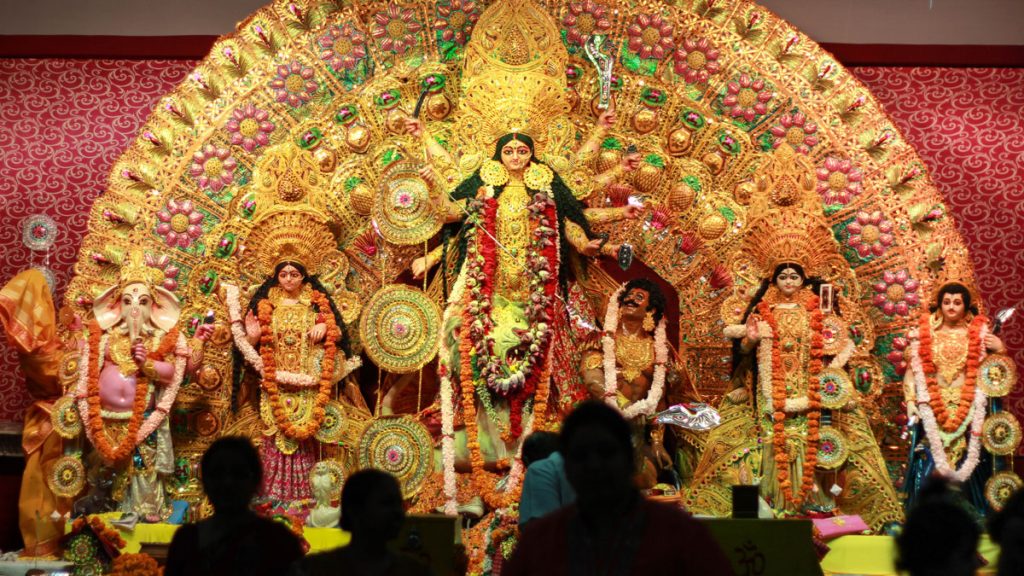There’s a world-famous phrase called “Incredible India” Have you ever wondered why India has been crowned with the honourable title? If your answer is no, I bet you after you visit this country you definitely can’t refrain from saying “India truly deserves this title! This country is on the far side of your imagination when it comes to Hills, landscapes, oceans and more specifically festivals, temples, cultures and traditions that have not lost their significance and specialties that rose from 5000 BC till the present 21st century. The Durga Puja is one of the popular yet extremely significant festivals in India that has an astounding history. Pore over the blog to know more about this festival that has a powerful effect on bringing you India.
Recommended Tour packages
- Kerala Tour Packages
- Rajasthan Tour Packages
- South India Tour Packages
- Shirdi – Spiritual Tour Packages – (6 Days / 5 Nights)
- Homestays And Heritage Hotels (21 Days / 20 Nights)
- India’s Golden Triangle Tour Package (6 Days / 5 Nights)
What is Durga Puja?
Durga Puja, also called Durgotsava or Sharodotsav, is a popular annual Hindu Festival resplendently celebrated for ten days in West Bengal, Bihar, Assam, Tripura, Odisha, Jharkhand, Uttar Pradesh and some other countries like Bangladesh, Nepal, Sri Lanka to honor and to pay reverence to Goddess Durga an incarnation of Goddess Parvati. The festival has a significant place in the Indian calendar, falling on the Hindu month of Ashvin, (September–October).
Why Durga Puja is celebrated?
The history of Durga puja is gripping as it is celebrated to commemorate good over evil. According to Hindu mythology, Mahishasura – a shapeshifting demon, gained immense power from his devotion to Lord Brahma and was offered a boon that made him invincible against every male being.
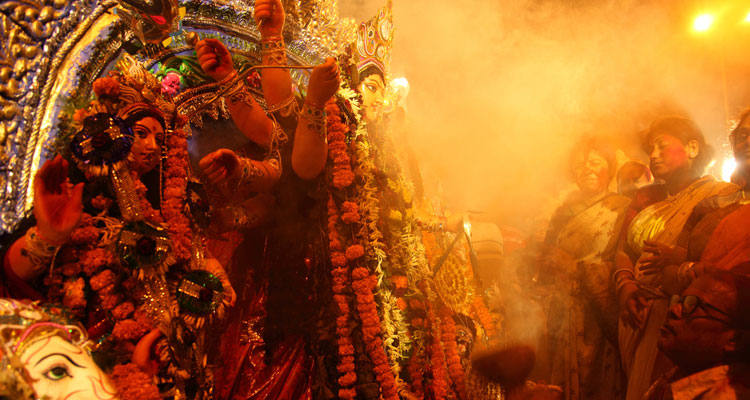
Also Read:- Do Jyotirlinga Temples Follow Lord Shiva’s Conch-Shaped Fibonacci Pattern?
With his new power, he unleashed a force of terror across the universe. Unable to defeat Mahishasura, all the gods sought help from Lord Shiva, who suggested all of them to combine their forces and create a powerful female warrior to defeat him. Therefore, Goddess Durga was born from the collective energies of many gods and goddesses. She was offered weapons by various deities and rode into a battle with a lion. After nine days of fierce fighting, Durga finally defeated Mahishasura on the tenth day and that is why people celebrate the victory of Goddess Durga as a grand festival.
India’s Triad Celebration
Durga Puja is very popular, particularly in the Indian state of West Bengal. But the festival’s celebration is not only limited to West Bengal, as the zestful vibe is passed on to other parts of the country as well in the form of a “Triad celebration” which includes Dussehra, Navaratri, and Ayudha Pooja that is celebrated in various parts of India Simultaneously within nine days. The first 3 days of the celebration are dedicated to Goddess Durga, the next 3 days are dedicated to Goddess Lakshmi and the last 3 days are dedicated to Goddess Saraswati.
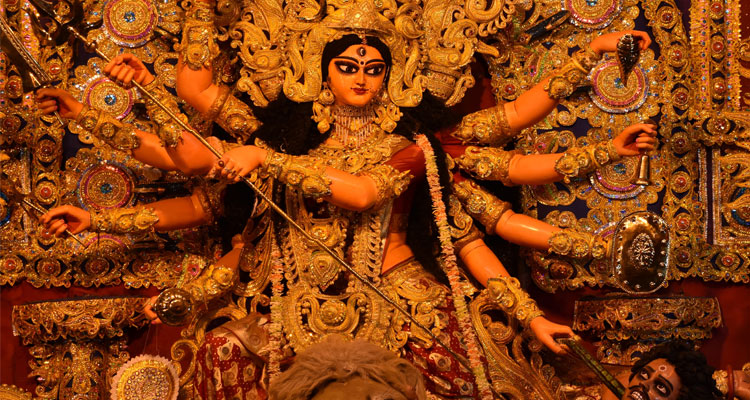
Also Read:- 10 Famous Ganesh Temples To Visit In India During Ganesh Chaturthi
All three festivals are appertained for the same reason of celebrating Durga Pooja. Each festival owning the same history is celebrated differently. Dussehra celebrates the Victory of Lord Rama who fought against Ravana for nine days and defeated him on the tenth day for abducting his wife Sita. One of the main rituals associated with Dussehra is the burning of huge effigies of Ravana. But some legends suggest that Dusserhra also commemorates the victory of Goddess Durga. Navaratri is a nine-day festival dedicated to Goddess Durga. It is believed that Goddess Durga took nine avatars to kill the demon named Mahishasura. Ayudha pooja is a popular festival especially, in South India where people honor all the instruments used in daily life and worship Saraswati – Goddess of prosperity and Durga – Goddess of power.
The Splendid Celebration of Durga Puja
Have you ever wondered about “how do people celebrate Durga Puja?” I’m sure that your boundaries of imagination will not be sufficient when you think about this festival because the celebration is grand, mesmerizing and astounding as Kolkata’s famous Durga puja has been reorganized by the United Nations Educational, Scientific and Cultural Organization (UNESCO) and has been included in Intangible Cultural Heritage of Humanity list (ICH). Here are some of the highlights of the Durga Pooja celebration that will linger in your mind until you visit Kolkata.
1. The Idol – A lump of clay turned into a divine structure
An immense figure adorned with jewels, clothed in red, resting on a Lion, staring at the public with her beautiful big eyes, having multiple arms each holding a weapon symbolizing the protection of lives – The Idol of Goddess Durga truly signifies beauty and it is one of the integral part of the Durga puja. The creation of the Idol commences a month before the arrival of Durga puja. The straw-stuffed modules of the goddess’s anatomy are layered by clay and mud from the holy river Ganga and soil collected outside a prostitute’s home.
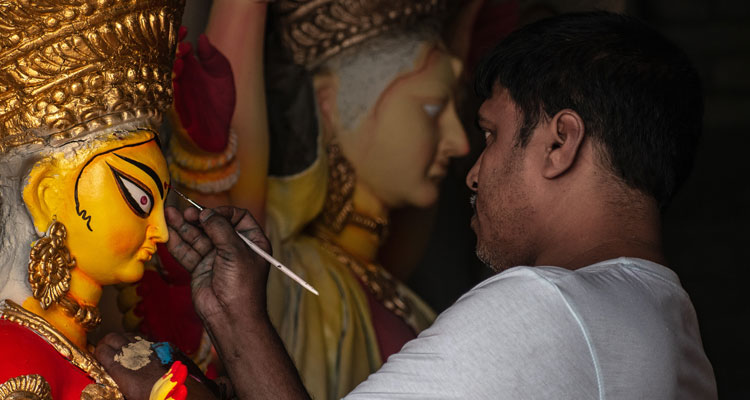
Also Read:- What are the benefits of visiting Navagraha Temples? | Defeat Problems with this Tamil Nadu Temple Tour
Legends suggest that a man abandons his truth and purity when he enters the house of a prostitute. Therefore, all his purities are left in the soil outside their house. The credit of turning a lump of clay into a divine idol goes to Kolkata’s local artists who have the greatest hands in bringing goddess Durga to life with their impeccable craftsmanship. Artists toil to capture the depth and intensity of the idol’s gaze, which is said to be both fierce and compassionate. This artwork is not only just an exhibition of the hereditary craft work but also serves as a source of livelihood for the idol makers as they get a huge turnover through sales.
2. The Pandals – A hub for worship
The Pandals are temporary structures that are built using bamboo, wood and other materials in a particular space especially to venerate God/Goddess. This serves are the focal point for the devotees to gather and worship. The structure and decoration of the Pandals have evolved and have become innovative every year as professional artisans work tirelessly to create visually stunning designs that captivate devotees and visitors alike.
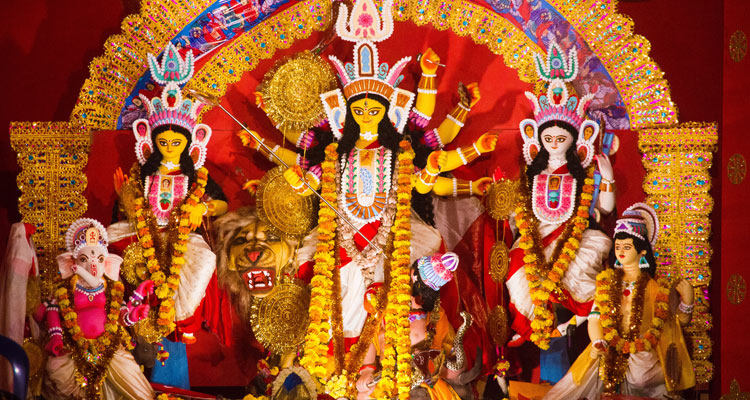
Also Read:- 20 Beautiful and Powerful Temples in Tamil Nadu to Visit with Your Family – Part 1
Pandal’s interior features beautiful paintings, intricate artwork, sculptures and lighting that enhance the overall ambiance. The statue of Goddess Durga is placed on a pedestal in the center of the pandal and is surrounded by statues of her four children – Saraswati (goddess of knowledge), Lakshmi (goddess of wealth), Kartikeya (god of war) and Ganesh (god of wisdom)
3. Theme Pandals – A visual treat
Even the non-believers would bounce off the walls to visit the Pandals of Goddess Durga especially to feel the divine ambiance to the fullest. One of the fascinating features that attract people to visit Durga puja is the “Theme Pandals”. Constructed as large beautiful structures, adorned with lights, intricate designs, and astounding artwork – The theme pandals are built in the form that depicts mythological stories, contemporary social issues and a replica of monuments or palaces that are famous in India and around the world.
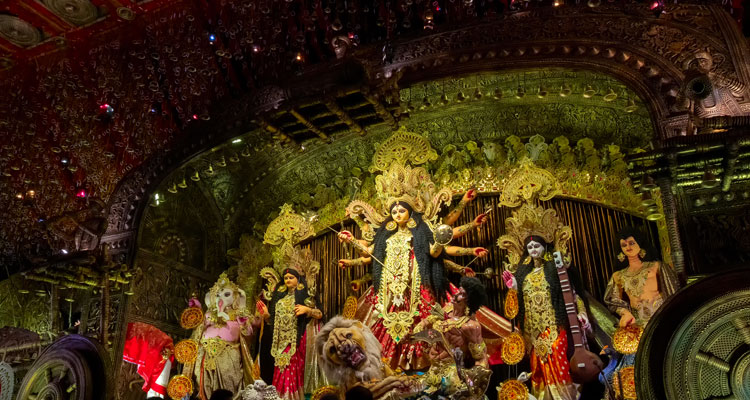
Also Read:- 10 Strange and Unbelievable Destinations in India – Part 1
One of the prominent features of the theme pandals is that divides of caste, class, and ethnicity get collapsed in the crowd. The pandals also house various stalls that have various unique products that are often associated with the festival, ranging from festival attires, ornaments, and beautiful artworks to lip-smacking varieties of Bengali dishes. Hence visitors can experience “The joy of shopping”
4. Worshipping Goddess Durga – A soulful experience
For the person who is seeking spiritual solace, experiencing the divine vibe while worshipping Goddess Durga is a must. The most integral part of Durga puja is the “Dhaak” and Aarthi. Dhaak is an important traditional music that belongs to West Bengal and Dhaki is the one who plays dhaak along with other instruments such as organ, flute and cymbals. Dhaak’s association with Durga Puja is beyond the musical role. It has cultural and religious significance as it symbolizes energy, power and victory.
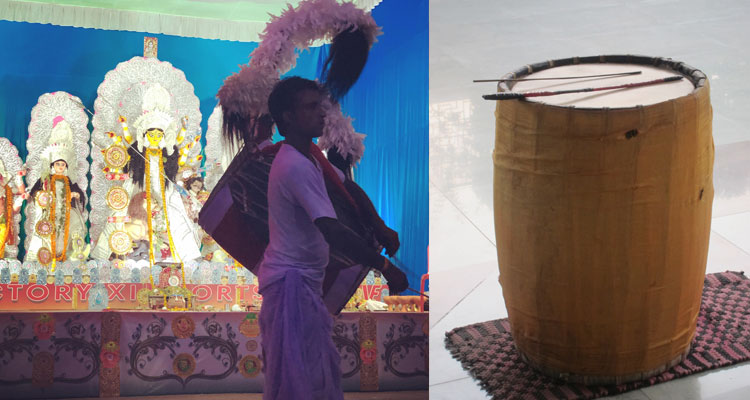
Also Read:- 10 Places to Visit in India Before You Die | Incredible India Tour
It is believed that the sound of Dhaak evokes optimistic energies among people, creating a sense of divinity and enthusiasm. The aarthi begins with the lighting of a lamp or camphor, which is a symbol of expelling the darkness and ignorance. There are many purposes for performing aarthi during Durga Puja. First, the fluctuation of lights symbolizes the evil driving force and adds good feelings to life. This is also a way to show gratitude and effort to God. The Aarthi ceremony is accompanied by the loud beating of drums, blowing of conch shells and ringing of bells, creating a very powerful and important atmosphere.
5. Celebration of Womanhood – Honouring feminine energy
Do you know what Shaktism is? – It is one of the major sects of Hinduism in which metaphysical realities are likened to a woman. The history of Durga puja itself proves and portrays that a woman is a “Great Warrior” who is bestowed with the ability the defeat evil even when the men do not possess it. Hence Durga Puja celebrates the power and strength of the woman who can overcome challenges and adversities like the Goddess Durga overcame.
Also Read:- The 8 Mysterious and Interesting Temples to Visit in India | The Strangest Temples of India (Part 1)
To celebrate the honor that Goddess Durga gave to womanhood, women in Kolkata dress up in traditional West Bengal outfits and go on a procession along with Goddess Durga’s idol which is carried through streets in a beautifully decorated palanquin. The experience of attending the procession will be astounding as it will be a visual treat to see women beautifully dressed up, chanting mantras and dancing joyfully to the traditional Bengali music. Not only the women but also the whole city vibe to the divine and electrifying ambiance.
Temple to visit during Durga Puja
Vaishno Devi Temple in Jammu and Kashmir, Mansa Devi Temple in Uttarakhand, Chamunda Devi Temple in Himachal Pradesh, Kamakhya Temple in Assam, Amba Mata Temple in Gujarat, Dakshineswar Kali Mandir in Kolkata and Karni Mata Temple in Rajasthan.
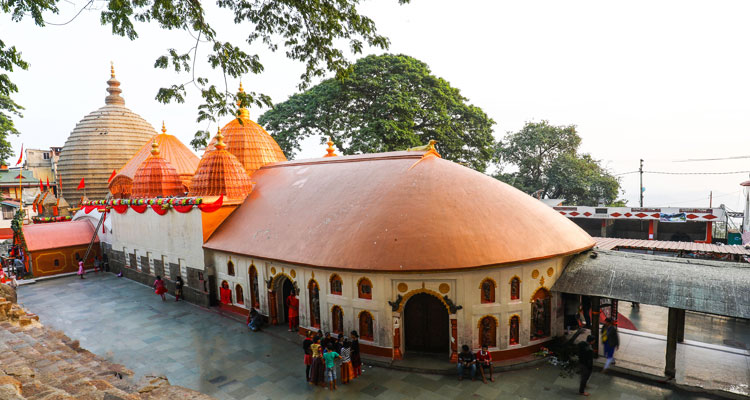
Also Read:- The 8 Mysterious and Interesting Temples to Visit in India | The Strangest Temples of India (Part 2)
Whatever may be the culture and traditions of India, they are always encapsulated with scientific reasons that only a few are aware of. Here are some of the facts of Durga Puja that have incredible scientific reasons.
1. Intermittent fasting – An ancient hack useful to Modern day.
Have you heard of Mitochondria? It is the powerhouse of the cell that turns food into energy and for a particular period, the cell needs rest. During Durga puja, people are involved in intermittent fasting, where people consume light food and avoid non-vegetarian foods or go without food. People do this intermittent fasting because of the seasonal changes and its impact on the digestive system. September to October is a period in which the world experiences rapid seasonal changes.

Also Read:- Spiritual Tourism – The Rising Travel Trend!
Mid- September marks the beginning of autumn and because of this the temperature seems to be moderately cooler and the daylight is more than usual. This abnormal combination of atmospheric conditions paves the way for various health issues for those with weak immune systems. Hence fasting during this particular period is a reminder to people to be cautious about maintaining good gut health which aids in the detoxification of Mitochondria.
2. Navaratri – Cosmic power on humans.
Navaratri means Nine Nights. According to Vedic astrology, it is said that each planet influences, and has an impact on the human body and mind. Individuals are driven by the cosmic power concerning their planetary position. The impact of planetary position can be positive and negative varying from person to person so individuals must reach a state of harmony in both their body and mind. To maintain tranquility and sustain happiness, people in their homes organize Golu, also called Bommai Kolu or Bommala Koluvu – A traditional display of dolls and figurines that is an integral part of the Navaratri in South India.
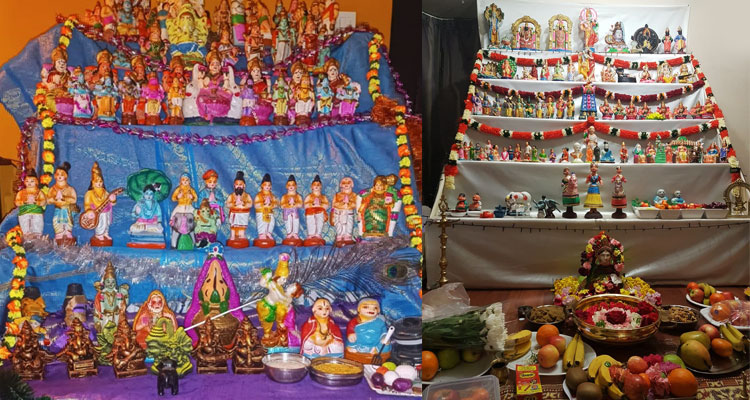
Also Read:- Why Should You Visit India? Top 10 Reasons To Visit India
Golu is a way to bring families and communities together. During Navratri, people visit each other’s homes to watch Golu displays, exchange gifts and participate in cultural events. This relationship fosters a sense of belonging, strengthens relationships and promotes social cohesion dragging out the stress that had built up in a person. Research shows that social interaction is beneficial for mental health and well-being.
3. Navaratri – Induces happy hormones
As, Golu is famous in South India during Navaratri, Popular dance known as “Garba” is famous in North India. Garba is a traditional Gujarati folk dance that is performed in open spaces during the time of Navaratri. Not only the performers but also the audience who come in mass numbers dance like no one is watching!
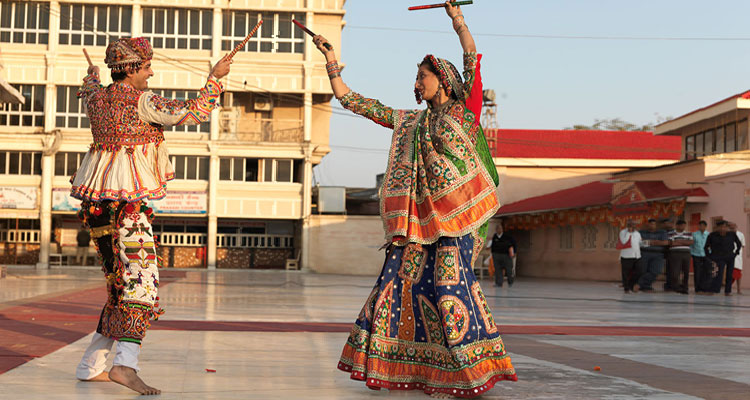
Also Read:- UNESCO World Heritage Sites in India – Part 1
Dandiya Raas is a traditional folk dance form, originating from the Indian state of Gujarat and is popularly performed during the Navratri Festival. Dancers come together in colourful attire, wielding decorated sticks called “dandiyas,” creating an energetic and rhythmic spectacle that elevates the festive fervour. Dandiya Raas is also performed with great enthusiasm in the Marwar region of Rajasthan.
As mentioned earlier, since Navaratri is a period that invites discomforts to the physical and mental health of humans the act of dancing helps to ease out all these issues. Dancing reduces stress, negativities and activates the seven centers of the body and promotes the effect of pain tolerance. Researchers suggest that dancing releases a hormone called endorphin, which is responsible for improving moods and inducing a sense of feeling good. It is a way to connect with the inner energies and positive vibrations through which with every step and every beat all the adversities and negative thoughts are dragged out.
4. Vermilion and Bangles – A priceless gift for women
In India, you could see every married woman wearing a vermilion, famously known as Sindhoor on the forehead. Women, on the last day of Durga puja, apply vermilion on their forehead more than the usual amount while worshipping goddess Durga, as she represents auspiciousness, fertility and martial blessings to womanhood. But the scientific reason for wearing a vermilion is astonishing.
Also Read:- 1000 Years Old Temples in India | The Ancient Temple Series: Karnataka
Vermilion is made of turmeric lime and mercury which is more effective in controlling blood pressure, activating sexual drive and aiding in maintaining the temperature of the body. Women adorn their hands with mehndi and beautiful red bangles during the puja. Mehndi has a cooling effect on the body and these bangles press the veins underneath the hands which helps in increasing the blood flow to the reproductive system resulting in easy conception.
5. Strong social bond – Community well-being
Durga comes gifting people with a long holiday. People from various countries and places arrive at Kolkata to celebrate this festival and most importantly to meet their loved ones. People who were once piled up with stress, weariness and depression due to work or other issues, come together during Durga puja and celebrate the festival to their fullest. The celebration of Durga puja, the cultural events, dance and shopping infuses happy hormone in the minds of every individual as these events helps in eradicating the existing stress.
Also Read:- Top 5 Obvious Benefits of Travelling | Learn Why Travel Makes You a Better Person
For women, Durga Puja is their big “Gala Day” as they will be provided with the chance to step outside their homes and participate in many cultural activities. Since women in North India rarely get the opportunity to roam out and spend time quality time for only themselves, Durga Puja acts as a bridge that enables women to mingle and create strong social bonds striking out the feeling of isolation.
What is world is insisting now was once already discovered and practiced by the Indian’s ancestors. Come across those wonders, celebrations and visual treats that India awaits you to experience. Visit Kolkata to be a part of Durga Puja and carry millions of astounding memories with you.
Keep reading Indian Panorama blogs and follow us on Instagram and Facebook for regular updates and beautiful pictures of India with soulful captions.
Travel with Indian Panorama. The most loved travel family and India’s Leading Destination Management Company.
Indian Panorama will help you choose destinations and our Travel Guides will guide you to experience a joyous journey throughout the vistas of India.
Mail: enquiries@indianpanorama.in
Phone: +91 431 4226122
For more details and bookings, feel free to visit, www.indianpanorama.in and get a free quote for your tour itineraries

